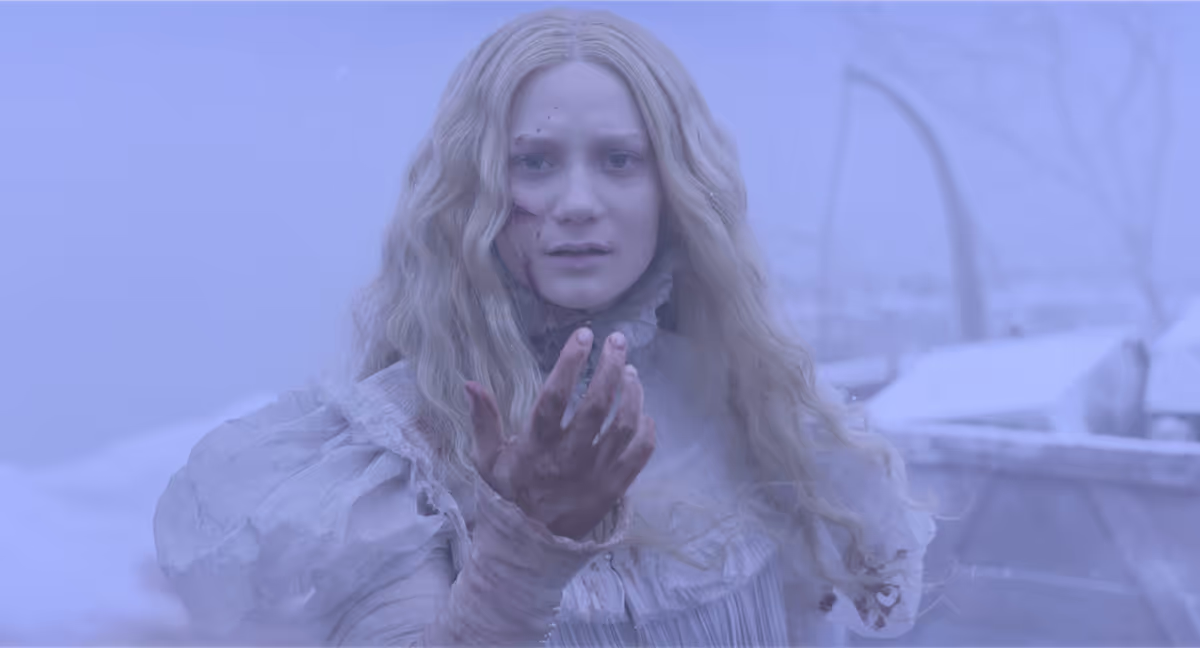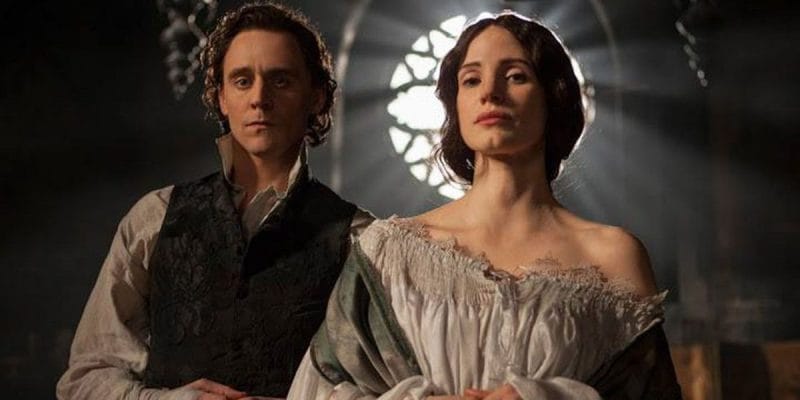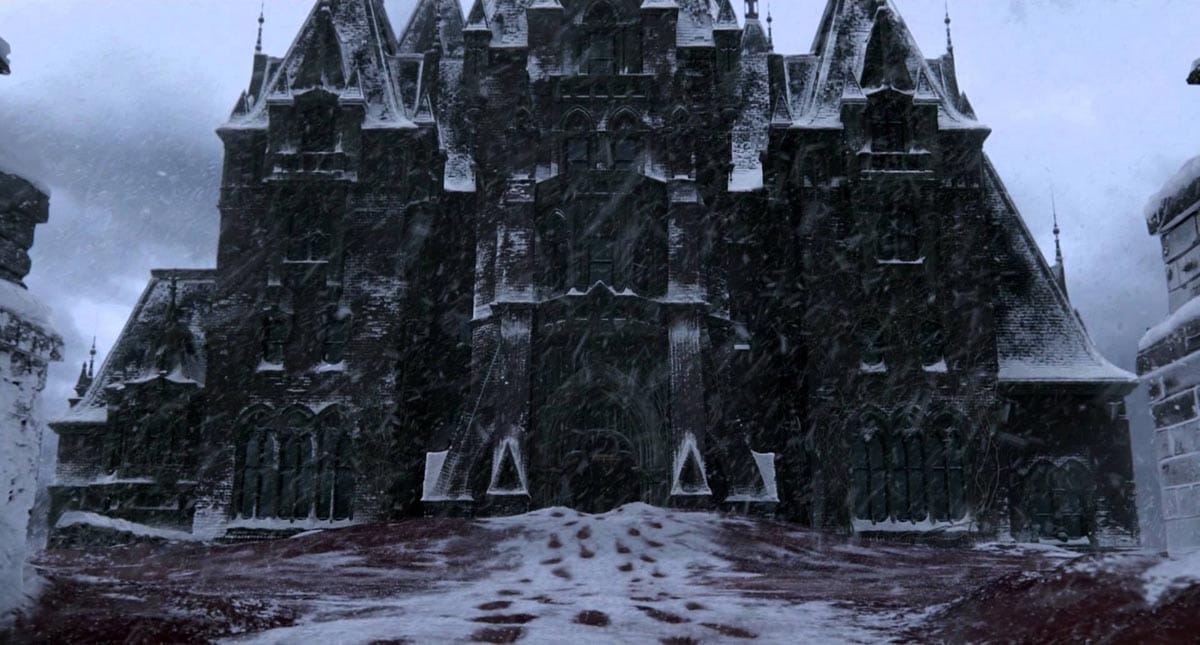The New Cult Canon: 'Crimson Peak'
After a couple of blockbusters, Guillermo del Toro cashed his chips on a period haunted house movie that's sumptuous, classical, and pleasingly deranged.

“You lied to me!”
“I did.”
“You poisoned me!”
“I did.”
“You said you loved me!”
“I do.” — Crimson Peak
Broadly speaking, the films of Guillermo del Toro can be placed in two different buckets: Impeccable period fantasies that are rooted in dark historical moments, like The Devil’s Backbone, Pan’s Labyrinth, The Shape of Water, and Pinocchio, or more swiftly paced mainstream spectacles like Blade II, the Hellboy movies, and Pacific Rim. Though these titles don’t divvy up quite so neatly—Hellboy, for one, begins with Nazis uncorking a dimensional demon portal as part of the war effort—del Toro brings a different energy to these projects, depending on the mood he’s trying to create. While the historical fantasies tend to get the most critical appreciation, including that Best Picture nod for The Shape of Water, a certain airlessness can creep into them, as if del Toro were too preoccupied by evocative bric-a-brac to inject enough urgency into the story. They can feel like art objects, missing the lowbrow punch of his more commercial outings.
The Reveal is a reader-supported newsletter dedicated to bringing you great essays, reviews and conversation about movies. While both free and paid subscriptions are available, please consider a paid subscription to support our long-term sustainability.
Enter 2015’s Crimson Peak, the best of both worlds: A turn-of-the-century haunted house movie, steeped in literary and filmic allusions, and a fevered, florid gothic romance that bursts with emotion, perversion, and unmistakable passion on both sides of the camera. It is simultaneously classical and bugnuts, a film that’s tied closely to the traditionalism of the genre standards like The Haunting and The Innocents while settling in an estate so flush with grisly family secrets that the ground literally bleeds red into the fresh-driven snow. Produced after del Toro made two straight studio blockbusters in 2008’s Hellboy II: The Golden Army and 2013’s Pacific Rim, Crimson Peak feels like a director cashing in his chips on an idiosyncratic personal project without abandoning that commercial pop. If anything, there’s an overweening abandon to the film that may have estranged a larger audience, but serves the material well. The operative word here is “florid.”
When you think of a film like The Haunting, Robert Wise’s 1963 adaptation of Shirley Jackson’s novel The Haunting of Hill House, perhaps you think first of the black-and-white photography and the creaks, groans, and bumps-in-the-night that accompany a paranormal investigation into a creepy old mansion. Haunted house traditionalism defined. Yet a big part of the film—and the subgenre—is a deeper psychological unrest, which makes characters sleepless and particularly vulnerable to ghosts, to the point where it’s hard to separate the authentically supernatural from a manifestation of trauma. In the opening narration of Crimson Peak, Edith Cushing (Mia Wasikowska) says, “Ghosts are real. This much, I know,” before going on to describe her first supernatural encounter at 10-years-old after her mother died of black cholera. It’s her mother’s withered ghost who warns her of “Crimson Peak,” but del Toro first lets us experience a little girl watching pallbearers carry her mother’s closed casket to the grave. “There were to be no parting kisses, no goodbyes, no last words,” she remembers. Losses like that leave a scar at a minimum. Here it leaves sinister vapors, too.

Del Toro, who scripted the film with Matthew Robbins, a ‘70s film-school brat whose career dates back to Steven Spielberg’s The Sugarland Express, packages Crimson Peak as a story within a story, with Edith as an aspiring Mary Shelley who’s misunderstood as an aspiring Jane Austen. With pale features that are ideally suited to the uncanny—Park Chan-wook had recognized that two years earlier by casting her in Stoker—Wasikowska plays Edith as an ambitious naif whose combination of inexperience and family wealth makes her an easy mark for grifters. As a young adult in 1901 Buffalo, Edith struggles like many women authors to place her first novel, opting to re-write the pages with a typewriter in order to keep publishers from getting distracted by her “feminine” text or demanding she include some romantic angle to the book. In the meantime, she lives comfortably off family money, which her father (Jim Beaver) manages judiciously, even though his protectiveness of her doesn’t come across as warmth.
The grifters arrive in the form of Sir Thomas (Tom Hiddleston) and Lucille (Jessica Chastain) Sharpe, who elbow their way into the Cushings’ high society circles by way of a title and a waltz. Charm does not come naturally for Lucille, but Thomas has it in spades, strolling confidently onto the scene as a “baronet” in search of investors for a revolutionary digging machine that can scoop up the soft red clay on his estate. Mr. Cushing smells a rat, but Thomas makes quick work of young Edith by praising her writing effusively and sweeping her along as a partner in his waltz demonstration, which is so fluidly orchestrated that he keeps a candle lit in his hand. For a young woman in search of adventure—and one now convinced that a romantic subplot in her novel might not be so bad—she cannot help but to swoon.
After hiring a detective who confirms his suspicions about the Sharpes, Mr. Cushing attempts to disentangle them from his family by cutting them a check to go away and forcing Thomas to break his daughter’s heart. He does this by attacking her work, which for a writer of wavering confidence is the most sensitive spot. He calls it “absurdly sentimental” and advises her to go back to her “ghosts and fancies” because she knows “precious little about the human heart or love or the pain that comes with it.” Crimson Peak pivots on this betrayal because you wonder if Mr. Cushing has coerced Thomas into telling the truth against his will: Edith really doesn’t know anything about love and the pain that comes with it yet, and so she may have to lean on naive fantasies or literary clichés to bring such subplots across. She’s about to get a hard lesson in love and loss.
Crimson Peak moves through this early section with a dizzying efficiency that whisks it forward to the estate of the title, where del Toro can really turn up the volume. The Sharpes present themselves as aristocrats but their ancestral estate might kindly be referred to as “rustic,” with an open floor plan in the sense that vast sections of the roof are missing and snow falls in neat piles on the floor of the Great Room. (The Danish cinematographer Dan Laustsen, whose ash-gray photography was the best and only memorable aspect of Silent Hill, has the time of his life with this setting.) The one possible source of the Sharpes’ restored prosperity is the lucrative red clay beneath the home’s surface, which represents at once a wellspring and a sinkhole. If the Sharpes can’t drain enough money from Edith’s inheritance to get their experimental mining technique to work, the estate will be submerged by the bloody goo seeping through the floorboards.

The ghost story aspects of Crimson Peak are mostly what you’d expect, less a mortal threat to Edith than a spooky warning of things to come. They’re understood as real, with wispy digital wraiths emerging from floors, walls, and even the vast clay tanks in the estate’s forbidden lower chambers, but it’s the Sharpes who are the real danger and they’re more complicated than they seem. Jessica Chastain has a tendency to get cast as more virtuous (or at least relatably flawed) characters, so to see her break out as a purely malevolent Lucille is a particular treat. She’s incapable of laying on the charm like her brother, so she seethes in the shadows as he seduces Edith, shows kindness only when she’s slipping bitter poison into Edith’s tea, and nearly always advocates for the most ruthless option. Her brother is the real grifter of the two; she’s the psychopath, the twisted product of her own ugly family history and an extended stay at an asylum.
Yet Crimson Peak is a love story, too, with Hiddleston’s Thomas stuck between his obligation to (and secret intimacy with) his sister and the redemptive goodness of the woman he’s chosen to bilk. Del Toro channels the hot-bloodedness of Italian horror throughout the film, choosing to ramp up both the brutality of the violence and the feverish urgency of what becomes a bizarre love triangle. At times, his historical fantasies can feel almost suffocatingly ornate, but the setting alone for Crimson Peak, which resembles an open wound, keeps the film thrillingly alive. “The marriages were for money but the horrors were for love,” goes one representative piece of del Toro and Robbins’ dialogue, channeling the spirit of a film that doesn’t wish to untangle horror and love any more than it wants to separate the living and the dead. Passion is the unifying force of del Toro’s universe here and it makes all things possible.
Next: Red Rooms




Discussion